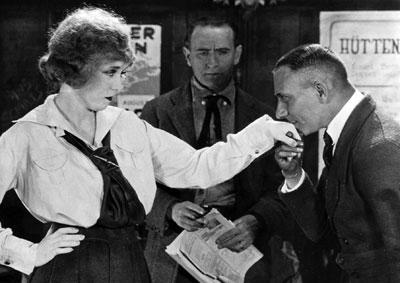Musical accompaniment provided by Robert Israel.
You are here
Blind Husbands (1919);
The Phantom of the Opera (1925)

Blind Husbands (1919)
Directed by Erich von Stroheim
Long before “the man you loved to hate” became “the director studios hated to love,” unemployed character actor Erich von Stroheim pitched Universal studio chief Carl Laemmle his original screenplay titled The Pinnacle, which featured a love triangle set among the peaks of the Tyrolean Alps. Captivated, Laemmle wanted to buy the story, but von Stroheim wouldn’t give it to Universal unless he was allowed to direct and star. Laemmle, well known for making important studio decisions based solely on his intuition, green-lit the project (eventually re-titled Blind Husbands) and shooting commenced April 3rd, 1919, on an alpine village set on the Universal backlot.
Much like his friend Rex Ingram (who also made his directorial debut at Universal), von Stroheim had a highly developed pictorial sense and obsession for detail which he used to shape Blind Husbands’ numerous visual possibilities into a story rife with sexual symbolism, while cameraman Ben Reynolds’ exceptional photography perfectly complemented his director’s vision. The small but accomplished cast articulated their roles with poetic clarity, but it is von Stroheim, the actor, who steals the picture. He clearly relished playing the unscrupulous “other man,” although he wisely deflates his womanizing character with jabs of occasional humor—before discrediting him entirely by story’s end.
By the time shooting finished on June 12th, 1919, the budget had ballooned to well over $100,000, and von Stroheim would spend the entire summer editing the vast amount of footage he had accumulated. After viewing the completed picture, Laemmle was certain the studio had something special on its hands, and ordered the advertising department to spend an additional $140,000 to promote the film’s release and its director. Both von Stroheim and Universal had much riding on the success of Blind Husbands, and the risk paid off handsomely. Audiences swarmed to the theatres in droves, and the picture quickly racked up impressive box office numbers worldwide. Critics praised it not as the promising first effort of a novice, but as a fully realized masterpiece by a mature artist—ultimately marking Blind Husbands as one of the greatest film debuts by any director during the silent era.
—Steven K. Hill
Universal Film Mfg Co. Producer: Carl Laemmle. Based on a novel by E. von Stroheim. Screenwriter: E. von Stroheim. Cinematographer: Ben F. Reynolds. Editor: Frank Lawrence, Eleanor Fried. Cast: Sam DeGrasse, Francelia Billington, E. von Stroheim, T. H. Gibson-Gowland, Fay Holderness.
35mm, silent, b/w, 92 min.
Preservation funded by the National Endowment for the Arts and the National Film Preservation Foundation.
The Phantom of the Opera (1925)
Directed by Rupert Julian
A former Universal stock player, Lon Chaney was a sensation in Universal’s The Hunchback of Notre Dame (1923) and two years later The Phantom of the Opera confirmed him as the silent era’s leading interpreter of horror roles. As Erik, the deformed “Phantom” who lurks in catacombs beneath the Paris Opera, Chaney conceived a legendary, grotesque character, famously employing wire hooks and other effects to give his face a pinched, skull-like quality that terrified 1925 audiences. A master of pantomime, Chaney played effectively to the story’s over-ripe air of Grand Guignol, surreptitiously offering vocal instruction to a young opera understudy (Mary Philbin) from behind a wall, then spiriting her away to his underground lair in the vain hope of winning her love. But the artistry of Phantom, probably Chaney’s best-known film today, belies the difficulty of its making and the volatility of Universal at the time.
Irving Thalberg had been chief of production at Universal since 1919. A precocious talent at 24, he streamlined studio operations through an impressive, centralized organization, but desired to position Universal as an equal with larger studios via costlier prestige pictures. His expensive (and successful) Hunchback was such a gambit but failed to spur a similar ambition in studio founder Carl Laemmle, prompting Thalberg to accept an offer to head the tonier Louis B. Mayer Pictures Corporation.
Laemmle and Universal charted a mostly conservative course for the next five years. But the Phantom project was in the pipeline, and then ascendant Chaney represented the studio’s best chance at a return on its investment in the property. Direction was entrusted to Rupert Julian (Merry-Go-Round) who clashed with Chaney, and whose original cut was coolly received by preview audiences. The picture opened later that year, significantly re-shot and reedited (a process repeated in 1929 for a “talkie” release). This series presents a version of the film that substantially recreates the 1929 release, including a color sequence, the famous “Bal Masque,” with Chaney, costumed as the “Red Death.”
—Shannon Kelley
Universal Pictures. Producer: Carl Laemmle. Based on the novel by Gaston Leroux. Screenwriter: Raymond Schrock, Elliott J. Clawson. Cinematographer: Virgil Miller. Editor: Maurice Pivar. Cast: Lon Chaney, Mary Philbin, Norman Kerry, Snitz Edwards, Gibson Gowland.
35mm, silent, b/w with color, 93 min.
To report problems, broken links, or comment on the website, please contact support
Copyright © 2025 UCLA Film & Television Archive. All Rights Reserved






 Mobile Navigation
Mobile Navigation
